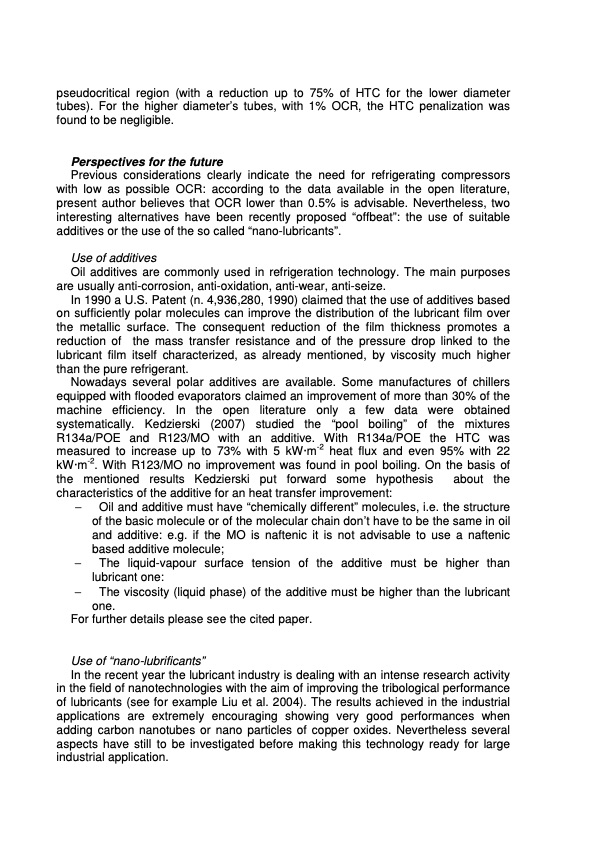
PDF Publication Title:
Text from PDF Page: 004
pseudocritical region (with a reduction up to 75% of HTC for the lower diameter tubes). For the higher diameter’s tubes, with 1% OCR, the HTC penalization was found to be negligible. Perspectives for the future Previous considerations clearly indicate the need for refrigerating compressors with low as possible OCR: according to the data available in the open literature, present author believes that OCR lower than 0.5% is advisable. Nevertheless, two interesting alternatives have been recently proposed “offbeat”: the use of suitable additives or the use of the so called “nano-lubricants”. Use of additives Oil additives are commonly used in refrigeration technology. The main purposes are usually anti-corrosion, anti-oxidation, anti-wear, anti-seize. In 1990 a U.S. Patent (n. 4,936,280, 1990) claimed that the use of additives based on sufficiently polar molecules can improve the distribution of the lubricant film over the metallic surface. The consequent reduction of the film thickness promotes a reduction of the mass transfer resistance and of the pressure drop linked to the lubricant film itself characterized, as already mentioned, by viscosity much higher than the pure refrigerant. Nowadays several polar additives are available. Some manufactures of chillers equipped with flooded evaporators claimed an improvement of more than 30% of the machine efficiency. In the open literature only a few data were obtained systematically. Kedzierski (2007) studied the “pool boiling” of the mixtures R134a/POE and R123/MO with an additive. With R134a/POE the HTC was measured to increase up to 73% with 5 kW·m-2 heat flux and even 95% with 22 kW·m-2. With R123/MO no improvement was found in pool boiling. On the basis of the mentioned results Kedzierski put forward some hypothesis about the characteristics of the additive for an heat transfer improvement: − Oil and additive must have “chemically different” molecules, i.e. the structure of the basic molecule or of the molecular chain don’t have to be the same in oil and additive: e.g. if the MO is naftenic it is not advisable to use a naftenic based additive molecule; − The liquid-vapour surface tension of the additive must be higher than lubricant one: − The viscosity (liquid phase) of the additive must be higher than the lubricant one. For further details please see the cited paper. Use of “nano-lubrificants” In the recent year the lubricant industry is dealing with an intense research activity in the field of nanotechnologies with the aim of improving the tribological performance of lubricants (see for example Liu et al. 2004). The results achieved in the industrial applications are extremely encouraging showing very good performances when adding carbon nanotubes or nano particles of copper oxides. Nevertheless several aspects have still to be investigated before making this technology ready for large industrial application.PDF Image | Circulating lubricant and effects of refrigeration circuits

PDF Search Title:
Circulating lubricant and effects of refrigeration circuitsOriginal File Name Searched:
zilio_inglese.pdfDIY PDF Search: Google It | Yahoo | Bing
NFT (Non Fungible Token): Buy our tech, design, development or system NFT and become part of our tech NFT network... More Info
IT XR Project Redstone NFT Available for Sale: NFT for high tech turbine design with one part 3D printed counter-rotating energy turbine. Be part of the future with this NFT. Can be bought and sold but only one design NFT exists. Royalties go to the developer (Infinity) to keep enhancing design and applications... More Info
Infinity Turbine IT XR Project Redstone Design: NFT for sale... NFT for high tech turbine design with one part 3D printed counter-rotating energy turbine. Includes all rights to this turbine design, including license for Fluid Handling Block I and II for the turbine assembly and housing. The NFT includes the blueprints (cad/cam), revenue streams, and all future development of the IT XR Project Redstone... More Info
Infinity Turbine ROT Radial Outflow Turbine 24 Design and Worldwide Rights: NFT for sale... NFT for the ROT 24 energy turbine. Be part of the future with this NFT. This design can be bought and sold but only one design NFT exists. You may manufacture the unit, or get the revenues from its sale from Infinity Turbine. Royalties go to the developer (Infinity) to keep enhancing design and applications... More Info
Infinity Supercritical CO2 10 Liter Extractor Design and Worldwide Rights: The Infinity Supercritical 10L CO2 extractor is for botanical oil extraction, which is rich in terpenes and can produce shelf ready full spectrum oil. With over 5 years of development, this industry leader mature extractor machine has been sold since 2015 and is part of many profitable businesses. The process can also be used for electrowinning, e-waste recycling, and lithium battery recycling, gold mining electronic wastes, precious metals. CO2 can also be used in a reverse fuel cell with nafion to make a gas-to-liquids fuel, such as methanol, ethanol and butanol or ethylene. Supercritical CO2 has also been used for treating nafion to make it more effective catalyst. This NFT is for the purchase of worldwide rights which includes the design. More Info
NFT (Non Fungible Token): Buy our tech, design, development or system NFT and become part of our tech NFT network... More Info
Infinity Turbine Products: Special for this month, any plans are $10,000 for complete Cad/Cam blueprints. License is for one build. Try before you buy a production license. May pay by Bitcoin or other Crypto. Products Page... More Info
| CONTACT TEL: 608-238-6001 Email: greg@infinityturbine.com | RSS | AMP |